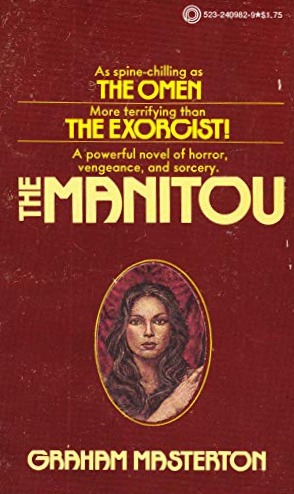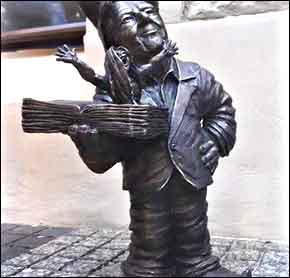By GRAHAM MASTERTON (Pinnacle Books; 1976)
The first and most famous novel by the ultra-prolific UK horrormeister Graham Masterton. THE MANITOU, which was eagerly compared to ROSEMARY’S BABY and THE EXORCIST, spawned six sequels and is, as of 2025, the only one of Masterton’s novels to have inspired a feature film (a so-so 1978 flick by director William Girdler). It’s not for nothing that a statue of Masterton in Wrocław, Poland (where a Masterton sponsored convict writing contest is held annually) depicts him holding a copy of THE MANITOU.
One thing that distinguishes THE MANITOU from so many of Masterton’s later novels is that, simply, it’s short (216 pages in its initial paperback edition). Masterton nonetheless crammed in an amazing amount of seemingly disparate elements, in which sense the novel is very much in keeping his subsequent detour-happy books. In 1976, however, there was evidently nothing else quite like THE MANITOU, as is made clear in an admiring introduction by author/editor Bernhardt J. Hurwood, who gushes that Masterton “takes the familiar concepts of horror and manipulates the reader with a totally shocking and unique combination of terror woven into a solid suspense yarn.”

Another pertinent quote is by Stephen King, describing one of his own books but inadvertently summing up THE MANITOU quite well: “it’s nothing but story—it moves with the goofy speed of a silent movie, and anything which is not story is cheerfully thrown over the side.” That story begins in a manner that prefigures ALIEN, with a tumor found on the neck of Karen Tandy, a young New Yorker. The case baffles doctors, not least because the tumor has a most unique property: it moves.
THE MANITOU MOVIE (1978) Trailer
Also involved is an element that prefigures GHOST (1990): a sham spiritualist named Harry Erskine who’s tasked with telling the story from his first-person perspective. He’s forced to delve into spiritual matters, with the Tarot and Native American—or, as termed here, Indian—mysticism figuring into a narrative that undergoes some impressive convolutions. Incorporated are modern (by 1970s standards) science, bodily possession, white guilt, prescient dreams, urban grit, a mutant birth, a centuries-old reanimated corpse (which somehow speaks modern English), an exorcism and a climax, involving an epic confrontation on a supernatural plain, that works better than of those of other similarly-oriented horror novels (such as KEEPER OF THE CHILDREN by William H. Hallahan).
Karen and Harry, as with this book’s every other character, could have stood to be a bit denser and more individual. Again, though, in THE MANITOU storytelling is everything; readers wanting something more are advised to look elsewhere.


